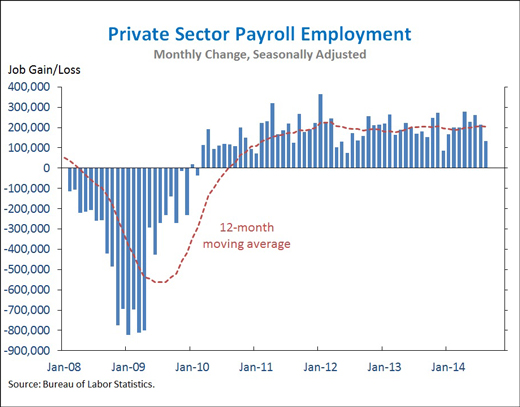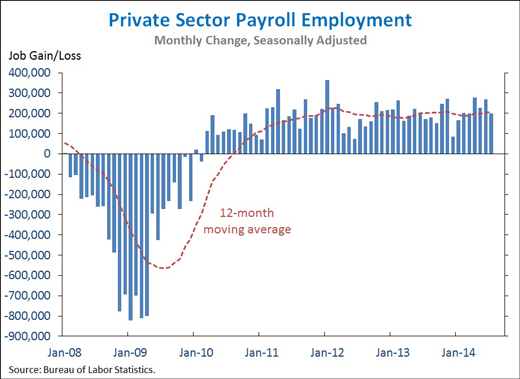Council of Economic Advisers Blog
Chart of the Week: The Persistent Gender Pay Gap
Posted by on September 19, 2014 at 10:45 AM EDTIn a country founded on the principle of equality, an unfortunate fact remains: Women still do not receive the fair pay that they have earned. This gender pay gap not only flies in the face of our national values -- it undercuts our economic growth and hurts the financial security of families across the country.
Looking back over the last 40 years, the wage gap narrowed from around 60% in the 1970s to above 70% in the 1990s, but progress stalled in the mid-2000s. For much of the last decade, women consistently earned 77% of what their male counterparts earned. But new data released this week shows that in 2013, the female-to-male earnings ratio climbed above 78% for the first time on record.
Take a look at the gender pay gap over the years to the recent progress, and more importantly, just how far we have left to go to achieve equal pay:
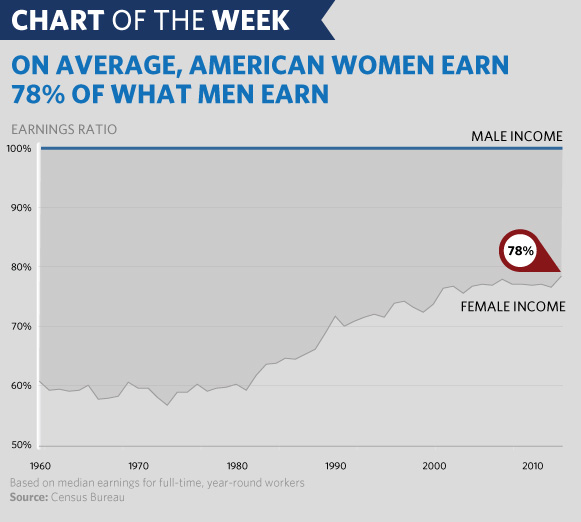
Income, Poverty, and Health Insurance in the United States in 2013
Posted by on September 16, 2014 at 11:03 AM EDTToday’s report from the Census Bureau shows that key indicators of poverty and family income improved in 2013. Moreover, there is reason to believe that this progress has continued into 2014, as the labor market has strengthened and millions have gained health insurance coverage. At the same time, the data also offer a clear illustration of the large amount of work that remains to strengthen the middle class in the wake of the worst recession since the Great Depression. To address this challenge, the President will continue to do everything in his power to ensure that hard work pays off with decent wages and financial security. And he will also continue to push Congress to take constructive steps that invest in job creation, boost wages, and ensure equal pay for equal work.
FIVE KEY POINTS IN TODAY’S REPORT FROM THE CENSUS BUREAU
1. The overall poverty rate declined to 14.5 percent in 2013 due to the largest one-year drop in child poverty since 1966. The poverty rate for people under age 18 fell by 1.9 percentage point from 2012 to 2013, equivalent to 1.4 million young people lifted out of poverty. Poverty rates for other age groups (18-64 and 65+) were little changed. The official poverty rate for 2013 remains above its pre-recession rate. This official poverty rate does not reflect the full effect of anti-poverty policies because it excludes the direct effect of key measures like the Supplemental Nutrition Assistance Program (SNAP) and the Earned Income Tax Credit (EITC). Notably, the EITC was expanded in 2009, and those expansions were subsequently extended. Accounting for such policies would reduce the number of people counted as being in poverty by millions.
 Learn more about Poverty
Learn more about PovertyThe Employment Situation in August
Posted by on September 5, 2014 at 9:30 AM EDTWith today’s report, the economy has now added 10 million private-sector jobs over 54 straight months of job growth. This figure is a marker of the progress that has been made, but also a reminder that more must still be done to create jobs, especially for the long-term unemployed, and grow the middle class. Although the pace of job gains in August was below recent months, the broader trends are moving in the right direction. To continue to support the progress our economy has made, the President will act wherever he can to create good jobs, facilitate investments in American infrastructure and manufacturing, and make sure that hard work pays off with higher wages.
FIVE KEY POINTS IN TODAY’S REPORT FROM THE BUREAU OF LABOR STATISTICS
1. The private sector has added 10 million jobs over 54 straight months of job growth, extending the longest streak on record. Today we learned that total nonfarm payroll employment rose by 142,000 in August, mainly reflecting a 134,000 increase in private employment. Private-sector job growth was revised up for July and down for June for little total revisions. Over the past twelve months, private employment has risen by a total of 2.4 million.
Learn more about , , , EconomySecond Estimate of GDP for the Second Quarter of 2014
Posted by on August 28, 2014 at 9:30 AM EDTToday’s revision affirms that economic growth in the second quarter was strong, consistent with the recent string of solid job growth and improvements in other economic indicators. But there's more work that needs to be done to build on this momentum. That is why the President continues to act on his own to facilitate investment in American manufacturing, energy, and infrastructure, as well as take steps to improve the financial security of working families.
FIVE KEY POINTS IN TODAY'S REPORT FROM THE BUREAU OF ECONOMIC ANALYSIS
1. Real gross domestic product (GDP) increased 4.2 percent at an annual rate in the second quarter of 2014, according to the second estimate from the Bureau of Economic Analysis. The strong second-quarter growth represents a rebound from a first-quarter decline in GDP that largely reflected transitory factors like unusually severe winter weather and a sharp slowdown in inventory investment. Growth in consumer spending and business investment picked up in the second quarter, and residential investment increased following two straight quarters of decline. Additionally, state and local government spending grew at the fastest quarterly rate in five years. However, net exports subtracted from overall GDP growth, as imports grew faster than exports. Real gross domestic income (GDI), an alternative measure of the overall size of the economy, was up 4.7 percent in Q2.
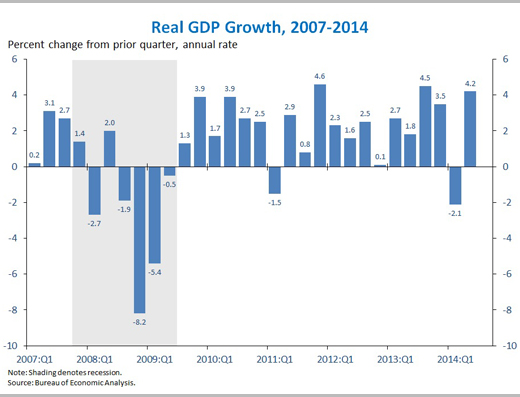 Learn more about Economy
Learn more about EconomyThe Employment Situation in July
Posted by on August 1, 2014 at 9:30 AM EDTTotal job growth exceeded 200,000 for the sixth straight month in July, the first time that has happened since 1997. This encouraging trend in the labor market is consistent with other recent economic indicators, including the strong second-quarter GDP growth reported on Wednesday. To ensure this momentum can be sustained, the President is pressing Congress to act to create jobs and expand opportunity, while simultaneously using his own executive authority to encourage investment in the United States, boost the income of working families, and ensure safe and fair treatment of American workers.
FIVE KEY POINTS IN TODAY’S REPORT FROM THE BUREAU OF LABOR STATISTICS
1. The private sector has added 9.9 million jobs over 53 straight months of job growth, the longest streak on record. Today we learned that total nonfarm payroll employment rose by 209,000 in July, mainly reflecting a 198,000 increase in private employment. Private-sector job growth in May and June were revised up slightly, so that over the past twelve months, private employment has risen by a total of 2.5 million.
Learn more about , EconomyAdvance Estimate of GDP for the Second Quarter of 2014
Posted by on July 30, 2014 at 9:35 AM EDTEconomic growth in the second quarter was strong, consistent with the recent further improvement in the labor market and other indicators. The economy could do even better if Congress does its part to help — starting with taking the steps needed to ensure that work on our roads and bridges is not brought to a halt this fall. But to make further progress, the President is pressing ahead on his own authority, taking action to facilitate investments in American manufacturing, energy, and infrastructure.
FIVE KEY POINTS IN TODAY’S REPORT FROM THE BUREAU OF ECONOMIC ANALYSIS
1. Real gross domestic product (GDP) increased 4.0 percent at an annual rate in the second quarter of 2014, according to the advance estimate from the Bureau of Economic Analysis. The second-quarter increase in GDP follows a first-quarter decline that was slightly less steep than previously reported. In the second quarter, growth in consumer spending and business investment picked up from the previous quarter, and residential investment increased following two straight quarters of decline. Additionally, state and local government spending grew at the fastest quarterly rate in five years. However, net exports subtracted from overall GDP growth, as imports grew faster than exports. Over the last four quarters, real GDP has risen 2.4 percent.
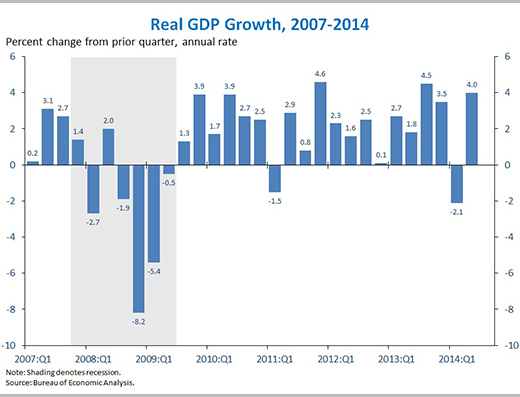 Learn more about Economy
Learn more about Economy
- &lsaquo previous
- …
- 4
- 5
- 6
- 7
- 8
- 9
- 10
- 11
- 12
- …
- next &rsaquo
White House Blogs
- The White House Blog
- Middle Class Task Force
- Council of Economic Advisers
- Council on Environmental Quality
- Council on Women and Girls
- Office of Intergovernmental Affairs
- Office of Management and Budget
- Office of Public Engagement
- Office of Science & Tech Policy
- Office of Urban Affairs
- Open Government
- Faith and Neighborhood Partnerships
- Social Innovation and Civic Participation
- US Trade Representative
- Office National Drug Control Policy
categories
- AIDS Policy
- Alaska
- Blueprint for an America Built to Last
- Budget
- Civil Rights
- Defense
- Disabilities
- Economy
- Education
- Energy and Environment
- Equal Pay
- Ethics
- Faith Based
- Fiscal Responsibility
- Foreign Policy
- Grab Bag
- Health Care
- Homeland Security
- Immigration
- Innovation Fellows
- Inside the White House
- Middle Class Security
- Open Government
- Poverty
- Rural
- Seniors and Social Security
- Service
- Social Innovation
- State of the Union
- Taxes
- Technology
- Urban Policy
- Veterans
- Violence Prevention
- White House Internships
- Women
- Working Families
- Additional Issues

